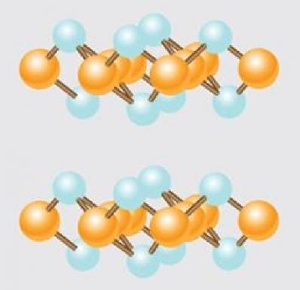Jul 13 2009
Superconductivity appears to rely on very different mechanisms in two varieties of iron-based superconductors. The insight comes from research groups that are making bold statements about the correct description of superconductivity in iron-based compounds in two papers about to be published in journals of the American Physical Society.
 Superconductivity appears to rely on very different mechanisms in two varieties of iron-based superconductors. Credit: American Physical Society [Illustration: Alan Stonebraker]
Superconductivity appears to rely on very different mechanisms in two varieties of iron-based superconductors. Credit: American Physical Society [Illustration: Alan Stonebraker]
The 2008 discovery of high-temperature superconductivity in iron-based compounds has led to a flood of research in the past year. As the literature mounts on these materials, which superconduct at temperatures as high as 55 K, two key questions are emerging: Is the origin of superconductivity in all of the iron-based compounds the same and are these materials similar to the copper oxide-based high-temperature superconductors (commonly known as cuprates), which physicists have studied for nearly twenty years but are still unable to explain with a complete theory?
These questions are addressed separately in two papers highlighted in the July 13 issue of Physics. A collaboration between scientists at Lawrence Berkeley National Lab, the SLAC National Accelerator Laboratory, Stanford University and institutions in Switzerland, China, Mexico and the Netherlands reports in Physical Review B x-ray experiments indicating that, in iron-based superconductors that contain arsenic or phosphorous (called 'iron pnictides'), the electrons that ultimately pair to form the superconducting state behave differently than those in the cuprates. More specifically, while the electrons in the cuprates are strongly correlated – meaning the energy of one electron is tied to the energy of the others – the electrons in the iron-pnictide superconductors behave more like those of a normal metal in which the electrons do not (to first approximation) interact.
In a paper appearing in Physical Review Letters, scientists at Princeton, UC Berkeley and Shanghai Jiao Tong University in China present the first photoemission measurements on an iron-based superconductor that contains tellurium, Fe1+xTe. They argue the origin of superconductivity in this type of iron compound, which belongs to a class of materials called the iron-chalcogenides, has a different origin than in the arsenic and phosphorous containing iron-pnictides. In fact, the measurements suggest that superconductivity in the iron-chalcogenides may be more similar to that of the cuprates.
The statements put forth in these two articles are likely to influence the direction taken by physicists who work on the theory of iron-based superconductors. See the Viewpoint article in the July 13 issue of APS Physics to learn more.